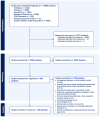Stress-Induced Ultrasonic Vocalization in Laboratory Rats and Mice: A Scoping Review
- PMID: 39595872
- PMCID: PMC11591760
- DOI: 10.3390/brainsci14111109
Stress-Induced Ultrasonic Vocalization in Laboratory Rats and Mice: A Scoping Review
Abstract
Introduction: Ultrasonic vocalization (USV) can indicate affective states-including psychosocial stress-in mice and rats. However, stress-induced USV changes could be confounded by laboratory experimental variables such as the type of behavioral stress paradigm, the elicitation method, rodent strain, etc. We sought to provide a review of the current literature to delineate how psychosocial stress-altered rodent USVs may be affected by factors of age, sex, strain, species, elicitation paradigm, and stressor. Methods: We used PubMed, Scopus (Elsevier), PsycINFO (EBSCO), and the following Web of Science (Clarivate) databases: Biological Abstracts, CAB Abstracts, Science Citation Index-Expanded, and Emerging Sources Citation Index. The studies identified by our search strategy were independently screened by two authors with the following inclusion criteria: peer-reviewed, in English, reported original data, and described USV in response to stress in rats or mice. The data extracted included USV acoustic parameters (mean peak frequency and mean amplitude (loudness)), details of the stress and USV elicitation paradigms, rodent species, age, and sex variables. Results: The following screening of 5309 titles/abstracts and 687 full-text articles revealed 148 articles. Footshock (20%), cold exposure (14%), and maternal separation (23.5%) were the most commonly used stress paradigms (duration and type of stressor varied across studies), with the total number of USV calls being the most commonly reported acoustic outcome. In rats, 121 articles described stress-altered USVs, while 25 studies reported the same in mice, and two reported multiple rodent species (rats and mice, alongside other rodent species such as gerbils). With respect to stress-altered USV changes with age, mice and rats increase USV rates after birth, with a peak around 6 to 10 days, and decrease USVs until weanling age. Of the five studies that reported sex-related differences in stress-induced USVs, females had an increased number of calls and lower average peak frequency in response to stress when compared to males. Only two to four studies reported strain-related differences in stress-induced vocalizations in rats and mice, respectively. Conclusions: The data from this review lay the groundwork for better understanding rodent USVs in response to psychosocial stress with effects of elicitation paradigm, stressor, age, and sex.
Keywords: mouse; rat; stress; stress paradigm; ultrasonic vocalization.
Conflict of interest statement
The authors declare no conflict of interest.
Figures
Similar articles
-
Eliciting adverse effects data from participants in clinical trials.Cochrane Database Syst Rev. 2018 Jan 16;1(1):MR000039. doi: 10.1002/14651858.MR000039.pub2. Cochrane Database Syst Rev. 2018. PMID: 29372930 Free PMC article.
-
Regional cerebral blood flow single photon emission computed tomography for detection of Frontotemporal dementia in people with suspected dementia.Cochrane Database Syst Rev. 2015 Jun 23;2015(6):CD010896. doi: 10.1002/14651858.CD010896.pub2. Cochrane Database Syst Rev. 2015. PMID: 26102272 Free PMC article.
-
Magnetic resonance perfusion for differentiating low-grade from high-grade gliomas at first presentation.Cochrane Database Syst Rev. 2018 Jan 22;1(1):CD011551. doi: 10.1002/14651858.CD011551.pub2. Cochrane Database Syst Rev. 2018. PMID: 29357120 Free PMC article.
-
A meta-analysis of sex differences in neonatal rodent ultrasonic vocalizations and the implication for the preclinical maternal immune activation model.Biol Sex Differ. 2025 Jan 25;16(1):4. doi: 10.1186/s13293-025-00685-9. Biol Sex Differ. 2025. PMID: 39863873 Free PMC article.
-
Education support services for improving school engagement and academic performance of children and adolescents with a chronic health condition.Cochrane Database Syst Rev. 2023 Feb 8;2(2):CD011538. doi: 10.1002/14651858.CD011538.pub2. Cochrane Database Syst Rev. 2023. PMID: 36752365 Free PMC article.
References
-
- Portfors C.V. Types and functions of ultrasonic vocalizations in laboratory rats and mice. J. Am. Assoc. Lab. Anim. Sci. 2007;46:28–34. - PubMed
Publication types
Grants and funding
LinkOut - more resources
Full Text Sources



